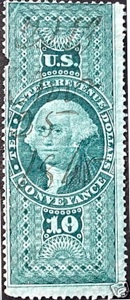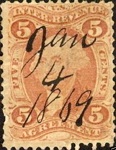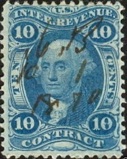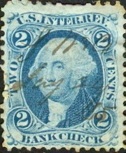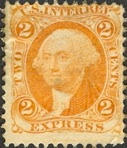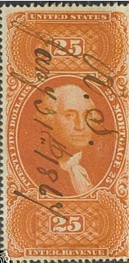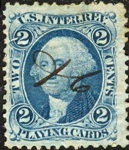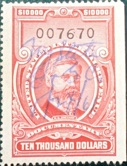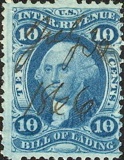BACKGROUND
In 1860, just before the Civil War started, residents of the U.S. paid no Federal taxes. Until then, Federal taxes had been imposed only twice, (1791 to 1802) and (1813 to 1817). In 1817 all Federal taxes on individuals and businesses were repealed. Prior to the Buchanan administration (1857-1861), which deliberately left the economy in shambles, all money needed to run the country was raised from customs duties on imports and the sale of public land. The government’s ability to generally stay in the black allowed Congress, in 1857, to lower tariff rates, which resulted in more Cuban cigars being imported in the United States than in any year before or since.
Unfortunately that same year saw the fiscal collapse of leading railroads and life insurance companies. Stock market tremors led to reduced imports at the same time the rates were lowered, plummeting the US into heavy debt. The Feds issued a series of short-term notes which subsequently it was unable to pay, and forced to reissue. With no money and the likelihood of war in the 1860 air, Congress made a series of poor decisions, including failing to pass a $1,000,000 budget item to repair the Navy. One Illinois congressman said “I am tired of appropriating money for the army and for the navy when, absolutely, they are of no use whatever.”
By 1860, the Government was faced with reduced revenue from reduced imports, political uncertainty (it was a very divisive election year), and paying high interest (15% to 36%) on the loans necessary to keep the government functioning. A new Secretary of the Treasury was appointed who managed to calm some Wall Street fears and sell notes at 12%. He also convinced Congress to raise import tax rates.
The Buchanan administration (just before Lincoln and the War) was described by one economic historian as “the miserable ending of the chapter on finances while they were managed by the South.” During the few months that General Dix, the new Treasury Secretary, managed the nation’s money he displayed wisdom and vigor; “but the evils previously wrought through a long course of maladministration could not be easily nor quickly cured.” Sound familiar?
Buchanan was heavily influenced by Southern Democrats, who did not want to leave the country fiscally sound if a Republican was elected in 1860 (Republican Lincoln was) and if there was to be a war (there was). Buchanan and the Southern Democrats succeeded in their goal. At the first meeting of Congress after the attack on Fort Sumpter in 1861, the Treasury Secretary reported Buchanan had given Lincoln a public debt of $90,867,828.68 (almost 91 million) with only $2,355,635.21 (a little more than 2 million) to cover it. He went on to say an additional $318,519,581.87 (well over 318 million) would be needed to run the Government in 1862. He admitted this was more than the country was able to borrow so raising taxes on the citizenry for the first time in 45 years was a must.
The Constitution allowed three forms of taxation: import duties, direct taxation, and by internal duties. Dix’s plan, in part, was to remove items like tea and coffee from the list of items exempt from import taxes, and raise fees on lightly taxed items like sugar. He pointed out other possibilities and left it “to the superior wisdom of Congress” to determine what to do. Unfortunately, both the Secretary and Congress were fiscally inexperienced without the skills to plan and pay for a long costly war (which most of them didn’t believe would happen). Also missing were people skilled and experienced in running a national tax system.
DIRECT TAXATION
The direct tax of 1791-1802 had been imposed upon “dwelling houses, land and slaves” and that of 1813-1817 upon “the value of all lands, lots of ground with their improvements, dwelling-houses, and slaves.” According to the 1860 census the value of real property in the United States was eleven and a quarter billion dollars with an additional five billion in personal property. Of the roughly sixteen billion, eleven was in the North and five in the states involved in the insurrection. The Treasury Secretary suggested rates between 1/8 of 1% and 1/5 of 1% would be sufficient. Not surprisingly, a direct tax was strongly resisted by many. Opponents argued that direct taxes would be unconstitutional since the Southern states wouldn’t be paying them and the Constitution required taxation to be apportioned equally among the states. The Secretary responded that the law required equal billing, and the fact the South wouldn’t be paying their bills didn’t negate the fairness of the assessment. Ironically, the non-paying Southern states had long favored direct taxation over import taxes since they were much more dependent on imports than the North.
One of the more interesting arguments in favor of the tax came from the New York Times which, on August 9, 1861, argued in an editorial that direct taxation would increase public awareness of government and help stem wide-spread corruption since people would be paying attention when it was their money, not import duties, that would be supporting the government. “The correction of the standard of morality in this regard will be worth many millions of dollars yearly to the public Treasury, and more than can be expressed in dollars to the general cause of honesty and virtue.”
Representative Roscoe Conkling offered an amendment to the House version of the tax bill. He wanted to require the states to collect the taxes as “perhaps the most obnoxious feature of the bill was that which created an army of officers to collect the tax.” His amendment was rejected as both unenforceable and unconstitutional, but expressed the public perception of tax collectors very well.
The direct tax finally approved by both houses (34-8 in the Senate and 89 to 39 in the House) ordered the tax to be based “on the value of all lands and lots of ground, with their improvements and dwelling-houses...at the rate each of them is worth in money on the first day of April, 1862.” A $500 exemption was granted to an individual’s primary residence. Slaves were not included as to do so would be a government certification of them as property, a rather touchy issue in the 1860’s.
Despite Conkling’s efforts to avoid a national tax bureaucracy, the bill authorized the President to nominate an officer in the Treasury Department to be called the Commissioner of Taxes who was to oversee the collection of the direct and the income taxes which were also levied by this act. The statute authorized the President to divide the States and Territories of the United States and the district of Columbia into convenient collection districts, and, with Senate consent, to appoint an assessor and collector for each district. All states except Delaware liked Conkling’s idea that they assume the tax collecting job (as Congress-approved incentives made it profitable for them to do so). Since States were so willing to accept the tax collecting burden Federal assessors and collectors were not immediately appointed. Over the course of the War, a national system of tax assessors and collectors was established.
The nation awaited being divided into tax districts until the war between the states was ended’s tax offices were located at the end of the War when states were re-united, go here.
INCOME TAXES
Adding an income tax to this first War Tax Bill was/is a bit of a surprise since such a tax was entirely new in this country. Addressing the problem of inequities inherent under the direct tax law as proposed (and passed) Representative Edwards of New Hampshire argued “Why should we not impose the burdens which are to fall upon the people of this country equally, in proportion to their ability to bear them?”
In 1861, by a margin of 77 to 60 an income tax of 3% on all incomes over $600 was passed by the House. The Senate changed it to 5% on net incomes more than $1000 and 7.5% on income derived from US property owned by US citizens living abroad. The Senate wanted interest income derived from holding Government notes to be taxed at only 2.5%. The final bill approved by the Compromise Committee provided for 3% on net income above $800, 5% on lands owned by citizens abroad, and 1.5% on Government securities.
No monies were collected under the tax bill of 1861 and by mid 1862 Congress had spent endless hours modifying the various tax bills as war debt mounted and debate continued as to how they were to be collected and by whom. The July 1862 income tax bill added a progressive element providing a 3% income tax on $600 to $1,000, a 5% tax on $1,000 to $50,000 and a 7.5% tax on income more than $50,000. A number of income exemptions were introduced including all state and local taxes. Manufacturers were allowed to deduct all forms of other taxes on materials or finished product they were required to pay under import or excise tax laws.
For the first time in this country’s history, the 1862 Income Tax Law ordered taxes to be withheld from payroll checks of all military and civil service personnel. Withholding worked a serious hardship on lowly-paid government workers who were dependent on a fiscally-stressed Congress for pay raises, causing many to leave government service and and go to work for private industry. The government, already badly in need of more white collar personnel to conduct a major war, was further stressed by this exodus.
By 1863, when the first taxes on cigars were placed, a book chapter’s worth of whereas and wherefore, therefore and in lieu of, exemptions and exceptions, had been sprinkled through to tax laws both refining them, making them more equitable, and providing loopholes big enough to drive a stagecoach through.
Debate continued constantly through the decade, as the income tax was due to expire in 1870. The Federal Tax Commissioner pointed out that most people in the country were in favor of keeping the tax, no doubt because only 250,000 residents paid income tax while 38,500,000 did not earn the $1,000 minimum income. In early 1870, Rep. Blair of Michigan contended that the Treasury could not afford to do away with the income tax: “every dollar which we take off this income tax, which applies to the rich men of the country, must be laid upon the poorer men of the country.”
Amendment after amendment was offered to the Income Tax law, with typical votes in the senate being 23 to 28, 26 to 22, 26 to 25, 27 to 21, 18 to 33, 26 to 26 and 25 to 25. Finally a two-year extension at a reduced rate, and other restrictions, was agreed to. The vote was highly skewed in the House with representatives from states paying the most in taxes voting strongly for repeal, those paying the least voting equally strongly for its continuance. New York, Pennsylvania, Connecticut, Massachusetts, New Jersey, Maryland, Rhode Island and California paid the vast majority of the total income tax, with New York having the majority of the nation’s wealthy citizens; that one state contributed from 28% to 39% of the total. Fifteen predominantly Southern and Midwestern states whose combined contribution to income taxes collected was a mere 11% voted 69 to 5 in favor of keeping it.
The Income Tax Law was repealed in 1872.
STAMP TAXES
The term “stamp tax” does not designate a distinct and
separate kind of tax,
but rather a method by which taxes were collected. Government-issued stamps pasted on goods had been a means of taxing in other countries for more than 200 years when proposed by the U.S. House of Representatives in 1861. Lincoln’s Secretary of the Treasury supported taxes on “paper evidence of debt and instruments for conveyance of property,” payment of which could be verified by requiring government stamps to be affixed.
The House Ways and Means Committee added telegrams, Express Co. receipts, warehouse and grain storage receipts, legal documents drawn abroad but enforced in the U.S., life and marine insurance policies, mortgages, medicines, preparations, perfume, cosmetics and playing cards to the list of items requiring a Federal stamp before being sold. Also added were official bonds of sheriffs, constables, executors, administrators, guardians, and the like. When the bill came to a vote, the House added a 2¢ tax on all bank checks written for more than $50. The joint Conference Committee lowered that to $20. A fine of $10 for every infraction was included, but forging tax stamps (a surprisingly common practice during the 1860‘s and 70‘s) carried the possibility of a $1,000 fine and five years at hard labor.
An unusual provision of the first tax stamp law was that permitting companies to design and print their own tax stamp (with the approval of Uncle Sam, of course). The person applying
government or proprietary stamps was required by law to place the stamp in such a way that it was torn in two when the package was opened. Whether government issued or privately printed, stamps were required to be initialed in ink by the person applying the stamp and the date when it was done. Failure to do so cost the miscreant $50 if caught. Attempts to avoid the law or reuse stamps resulted in fines of up to $100 and forfeiture of goods.
Stamp taxes were new to Congress and the governments involved, so modifications to solve problems were continual. Not long after the law was passed, an exemption was added for official documents necessary for carrying on the business of the Federal or all state governments. In 1862, the rules for cancellation of stamps were modified to permit printed cancellations since hand-initially them forced some companies to hire additional help to perform that task. The following year, cancellation rules were again modified, permitting the recipients of taxable goods to apply stamps if the required party failed to do so.
In 1863, the Tax Commissioner reported the stamp tax as “the most easily and cheaply collected and the most cheerfully borne” by the public. He went on to suggest the extension of the tax to other goods: receipts for payment of money, assignments and transfers of personal property, indentures of apprenticeship, bills of sale, articles of partnership, writs of execution, letters patent, certificates of copyright, college and university diplomas, and marriage certificates. The tax law was modified to apply to all checks, not just those over $20. Fines were doubled, tripled or quadrupled.
Cigar stamps are first required during this 1863 expansion of the law. Examples of the stamps required to be used on boxes of cigars under every change in the law for the following 100 years can be seen here. For those interested in the taxation of cigars, it is important that the 1863-1864 types of taxation based on the value of a box of 1000 cigars was repealed two years later as unenforceable at the tax office’s request. Hyman’s National Cigar Museum owns an official IRS letter admitting the confusion and difficulties with enforcing the first attempts at a tax law on cigars. In 1865, the system was changed radically; a uniform tax was established on all cigars, no matter the value, and Federal tax stamps were issued in specific denominations of 25, 50, 100, 250 and 500, thus establishing those as the only legal size boxes of cigars. To read about the early efforts by cigarmakers to circumvent these laws go here.
An unusual provision of the 1864 law gave local tax collectors the right to determine the rate of duty in certain cases; unfortunately the decisions of local assessors were sometimes an embarrassment to the Commissioner. Different collectors decided similar questions in different ways and sometimes at variance with the opinion of the Commissioner. Yet the decision of the collector was final. This was a legal incongruity that should not exist, but Congress failed to heed the Commissioner’s recommendation to add the right of appeal to the tax code in 1866. In fact, according to Dr. Smith and the Revenue Journal, no great upheavals in the tax laws occurred between 1866 and 1872. A notable exception was the far-ranging changes in laws pertaining to cigars and cigarmakers, including additional detailed reports, required signs on buildings, bonding of employees, permits, and how boxes were to be labeled and branded. These rules are detailed here.
Most Civil War stamp taxes had been repealed by the time the one cent tax on penny boxes of matches was repealed in 1883. Taxes on cigars and manufactured tobacco, beer, wine, liquor and playing cards (so-called sin taxes) remained as substantial sources of government revenue for the next century and a half.
Revenue stamps like these are available from Eric Jackson.
LICENSES a.k.a. “SPECIAL TAXES”
The Secretary of the Treasury did not include licenses among his proposals for taxation in 1861, but when the House Ways and Means Committee introduced its bill for internal taxes in March of 1862 they went much further than the Secretary requested. Among other taxes noted above, they pointed out that the Fed could make $3,000,000 annually by issuing licenses. “The license is not so much a permit for carrying on the business as a recognition of the trade and a designation of the premises in which the business is to be conducted,” he rationalized.
Neither the House nor the Senate objected. The biggest debate was over the cost of a liquor license and whether some paper-shuffling occupations required two licenses because they performed more than one service. The main opposition in the Senate was to the requiring of a license of cattle brokers and horse dealers. As finally passed, the law specified 33 trades or occupations which could not be exercised until a license had been obtained. Leaf dealers, cigar makers, and various types of peddlers were among those required to obtain one. Failure to do so would result in a fine three times the cost of the license.
A hot-button issue was the conflict between State and Federal Law. Can the Feds issue a license for an activity prohibited by State law? After great debate the law read “Nor shall any person carrying on any trade, business, or profession, for which a license is required by this Act, be exempt from procuring such license or from any penalty or punishment herein provided, by or in consequence of any state law either authorizing or prohibiting such trade, business, or profession.” In effect, the Feds said an applicant must take the risk. Federal Law requires a License but that doesn’t include permission to break State law. A few years later, wording within the law removed the word “License” (which implied permission and had been the subject of many court cases) in favor of the term “Special Tax.”
To secure a license (or Special Tax Receipt) the person or firm applying had to register with the Assistant Assessor of the district, giving the name, kind of business, and place where it was to be carried on. More informations was required of some. For example, peddlers were required to state how they intended to travel; innkeepers gave the rental value of the property they intended to rent. After paperwork was complete and tax paid to the collector or assistant collector, the license was issued.
If the licensee later moved, the change in business location was required to be noted on the license. Everyone was required to prominently display their license at the place of business. The law also required that any person pursuing more than one trade or occupation was required to obtain a license for both. There were exceptions to the latter: wholesalers could sell at retail; keepers of eating-houses could sell confections; wholesalers, retailers and hotel-keepers could sell tobacco; livery-stable keepers could sell horses; wholesalers and retailers could sell drugs; and similar. Definitions, especially as to who required a peddler’s license, were complex and often seem arbitrary today.
Most rates and requirements remained the same in 1863 except for wholesalers and liquor dealers, whose license fees became graduated based on the amount of business they did. The number of businesses requiring licenses was more than doubled by 1868. and ultimately included architects, pawn brokers, museums, jugglers, coffee grinders, miners, and breeders of horses and donkeys. Tobacconists were licensed in 1862 but repealed in 1868, the same year that a $10 license/Special Tax was required for cigar makers with sales from $1,000 to $5.000; cigarmakers with sales over $5.000 paid an additional $2 for each additional $1,000 in sales. Makers of chew, snuff, smoking tobacco and cigarettes were similarly licensed under the strict legal clampdown on the industry in 1868. Leaf tobacco dealers met the same fate, with a $25 fee if sales were not over $10,000 with $2 charged for each $1,000 more in sales.
Most License/Special Taxes were repealed as unnecessary in 1870 but Congress officially considered tobacco and booze to be luxuries. Repeal of the “sin licenses” would not come for more than seventy years.
TAXES ON MANUFACTURED GOODS
In 1862, the Treasury Secretary recommended a tax on distilled spirits and tobacco, but the House Ways and Means Committee believed that it was better to spread taxation around. By taxing more things, but at lower rates, the taxes would be more acceptable to the public, encouraging cooperation and payment. To avoid charging too much tax on any one product or service...basically, tax everything they could collect. A Law taxing “manufactured articles” was the result.
The bill contained two types of taxes, Specific and ad valorem (the amount it sold for). The idea was to levy the tax according to the method by which the assessment and collection could be more easily accomplished. Therefore, on articles which were all of the same quality (salt, turpentine, white lead) the specific rate was applied. Items which varied in quality but were easily classified (soap, tobacco, steel) were also charged a specific rate, but different for each quality grade. The ad valorem rates were applied to those articles whose values varied so much as to not be easily classified (umbrellas, paint, paper).
During discussion of this bill there was little debate on the general principle of taxing manufactured goods. What most States were interested in was keeping taxes low on items made in their states, while generally indifferent as to similar desires on the part of other states. Therefore debate tended to be rather sectional in nature. They did agree that leaf tobacco should be dropped from the list, as not qualifying as “manufactured.” Oddly, coal remained on the list of taxed goods. Raw cotton, too, remained on the taxable list, but at a very low rate.
The Act required that every person or firm engaged in the business of manufacturing should furnish a statement to the Assistant Assessor showing the proposed place of business, the name of the article to be produced, and whether it was for domestic or foreign market. Returns were to be made and taxes paid monthly, and if not paid within 10 days, they became a lien upon the real and personal property of the manufacturer. Refusal to comply was punishable with forfeiture of manufactured goods and a penalty of $500. An exemption was granted for goods made for the maker’s own use and for all goods made for sale up to a value of $600. Beer, liquor, cigars and manufactured tobacco had no exemption.
The Feds published a list which included a great many articles and the rate of tax. Specific taxes ranged from a tenth of a cent up to ten dollars, according to the kind and value of the goods. Ad valorem taxes varied from 3% to 5% with most getting the lower rate. The law did have a catch-all clause designed to tax all goods they left off the list. It read: “On all manufactures of cotton, wool, silk, worsted, flax hemp, jute, India rubber, gutta percha, wood, willow, glass, pottery-ware, leather, paper, iron, steel, lead, tin, copper, zinc, brass, gold, silver, horn, ivory, bone, bristles, wholly or in part, or of other materials, not in this act otherwise provided for, a duty of three per cent ad valorem.”
Each year thereafter, a few goods were shuffled back and forth, into and off of, the various lists. One significant change occurring in the second year was the reduction of two grades of manufactured tobacco products to one, as assessors accused manufactures of mis-reporting high quality goods as inferior to get the lower rate. After 1864, all tobacco products were charged the higher rate.
Cigars were involved in some of the longest more-heated discussions in Congress. The law of 1862 provided cigars be taxed according to their value. Five different taxes, broadly covering cigars selling for a penny to fifteen cents were established. Cigar makers reasonably argued that value should be based on the selling price of the cigars before the tax was added. If they increased the selling price of the cigars to include the cost of the tax, the assessors taxed the cigars at the higher price, thus forcing cigarmakers to pay tax on the tax. In some cases, the addition of tax was largely irrelevant. In others it made considerable difference. For example, if a man wanted to wholesale 2/5¢ cigars valued at $18/1,000, according to his interpretation of the law, the tax would be $2.50 bringing the total price to the retailer of $20.50. However, once the $2.50 is added bringing the value to $20.50 a new tax rate of $3.50 is incurred. This was the way Tax Assessors figured. A House amendment doing away with this inequity failed to pass in 1863 but, before that year’s tax bill was passed, the Senate forced the issue by passing the amendment and a joint House-Senate Committee concurred, the new law providing “the valuation of cigars herein mentioned shall in all cases be the value of the cigars exclusive of the tax.”
The next year the Tax Commissioner argued that the above amendment did not solve the problem. In many cases it was impossible for the assessor to determine, from the price at which cigars were sold, what the value was exclusive of the tax. He set forth the difficulty with the following example, paraphrased and elaborated from Smith, p. 233.
Take the case, for illustration, of a thousand cigars selling for $12. The sale determines the value, and the question is, “What is the tax?” There are two possible rates that could be applied, either $3 or $8. If it is $3, subtract the tax from the selling price of $12 and the result is the cigars, exclusive of the tax, are worth $9. But if cigars are worth more than $5 per thousand exclusive of the tax they must pay $8 in tax, which results in $17/1,000 cigars. But, if you take the original selling price of $12 and subtract an $8 tax, the value of the cigars, exclusive of tax, is only $4 and they qualify to be taxed at the rate of $5/1,000 making their total $9/1,000 not the $12 they actually sold for.
This same difficulty involving indeterminate and conflicting taxes and values occurs, he pointed out, with cigars selling at any price between $8 and $13, or between $22 and $30, and between $70 and $85. The unanticipated consequence of a price-based tax system with five different taxes was that it became more profitable for a cigar maker to sell his cigars at $11/1,000 than at $15/1,000; at $25 rather than at $31; at $69 rather than at $85, and at $84 rather than at $98. The tax law of 1865 did away with the dilemma by doing away with a five tier tax system and charged a flat $10/1,000 cigars no matter the price. This hit low priced cigars the hardest, and did away with penny cigars except sold in the black-market tax-avoiding back-of-the-wagon-on-saturday market which thrived in Pennsylvania through the 1930’s.
Setting uniform tax rates in 1865 and a series of other laws impacting cigars passed during the following three years had many consequences
(see Tax Wars), often more beneficial to today’s collectors than yesterday’s cigarmakers.
Anti-fraud provisions aimed at keeping cigarmakers honest were very similar to those provided for the collection of liquor taxes, such as requiring the manufacturer to bond their employees, to keep books with daily entries, render statements to collectors which showed the place of business, articles produced, machinery employed and
proposed market. Detailed instructions were given regarding the kind and size of packages and a stamp was required on every box, positioned so that it was broken when the package was opened. The 1868 laws demanded
ID’s and
Caution Notices as well. Cigar factories were scattered through both cities and rural countrysides, thus very difficult to monitor in the days when thousands of factories could be reached only on horseback. Numerous penalties were provided for the violation of the law and for the officers knowingly permitting or assisting in its violation. Early tax bulletins are filled with examples of the latter.
TAX DISTRICTS
After the Civil War, the Re-United States were divided into 243 tax districts, each assigned at least one Assessor and at least one Collector. Since there had previously been no taxes there were no experienced tax collectors. Office holders were almost universally patronage appointees, political hacks, brothers-in-law and others to whom the local Republican party owed a debt. These men were responsible for not only collecting taxes on liquor, beer and tobacco, but a long long list of of other products upon which war-taxes had been leveed during the very expensive war between the states including butter and newspapers. As taxes on these items were gradually repealed, the tax men increasingly focussed on beer, liquor and tobacco.
Over the next century, as tobacco planting, processing and manufacture spread and-or relocated, those taxes were continually adjusted according to the needs of the federal government...repealed, lowered, raised, re-written, loosened or made tighter. As transportation and communication improved, and the number of cigar and tobacco factories shrunk, the original 243 districts were consolidated, ending with a mere 50 by the mid 1950’s.
Because the Tax Laws of 1868 required the state and tax district to be incised or moulded into the bottom of every box of cigars, knowing where the various tax districts were located can be very helpful in identifying where cigars were made. The 3rd Dist. NY, for example, is lower Manhattan in New York City; 1st Dist. Illinois is Chicago and the surrounding area. Using that information in combination with the Federally assigned factory number (also required on every box of cigars) often allows collectors and researchers to identify who made a particular box of cigars. Most of that information about the location of Federal Tax Districts hasn’t been published for nearly 150 years, except here in Hyman’s National Cigar History Museum.
Lots more about taxes
Tax Wars Tax Districts
Import Taxes Cigar Tax Stamps Imported Cigar Tax Stamps
Canadian Cigar Tax Stamps NCHM Home

